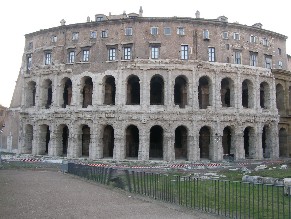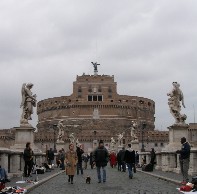Detroit and Rome have both had their share of prosperous and troubled times. Detroit has lost half its population since 1950: once a city of two million it is now home to around 900,000 residents. Many of its most significant buildings and factories now lay in ruins.
But Detroit’s difficulties pale in comparison to the fall of Rome, where a thriving population of around one million was reduced to tens of thousands barely hanging on for survival throughout the middle-ages. Many of Detroit’s industrial ruins, though abandoned and decaying, still stand as evidence of a stronger, more prosperous Detroit: monuments of a city and industry that once changed the world.
Rome returned from near extinction and in contrast, is now a thriving city of ruins. New and old buildings coexist in harmony through adaptation, re-use, and preservation and the result is a vibrant and flourishing city that is continuously redefining itself. What I am trying to figure out, and what I need your help with is this question: What can Detroit learn from Rome?
I spent a year in Rome studying the re-use of historic architecture and urban space throughout the city. Through photographs, sketches and diagrams I investigated how 23 different buildings and urban spaces in Rome survived and evolved within the urban fabric. I’ve selected a few of these case study sites and tried to elicit a series of lessons from each.
Rome has managed to successfully integrate its historic features into modern life, but the city also shares some of Detroit’s problems, such as sprawling suburbs and limited public transportation in some areas. Re-using an existing building is in many cases the only option considered for development within Rome’s urban core, but this solution goes beyond architecture. Preservation and sustainability are cultural values in Rome and they influence planning, policy and are part of a public commitment to keep the city alive.
Four urban scale projects are presented here. They each influenced the planning or development of Rome and are now permanently integrated into the city.

(1) Diocletian Baths served thousands of Romans before being abandoned in the 6th century. Michelangelo transformed portions of the ruins into a church and incorporated symbolic references to their original function. A new piazza and series of buildings were constructed to mimic another area of the bath complex and they form the termination of one of the city’s grand avenues.
The planning of buildings, existing ruins and city streets that were once voids, around a single site could be applied to the redevelopment of a large industrial park, such as the Packard Motor factory or Ford’s Highland park facility.
Could one of these industrial sites become the new venue for Detroit’s international auto show? City planners throughout Rome’s history tried to maintain both physical and symbolic connections between ancient and modern. Could the Woodward Dream Cruise be extended to somehow incorporate Detroit’s famous factory sites? Or could the area around the Detroit Dry Dock Company become part of a revitalized connection between the city and historic industrial waterfront?
 Two ancient Roman theaters influenced the city in very different ways. (2) The Theater of Marcellus’ heavy stone structure was used as a frame for apartment buildings over several hundred years. One side of buildings was removed to reveal the original theater façade and preserve it as an ancient monument. In contrast to this monumental face, the other side remains as a modest scale transition to a quiet residential area. (3) The Theater of Pompeii’s outline is evident throughout Rome’s Campo de’ Fiori neighborhood. Though the theater no longer exists, its foundations influenced the form of dozens of buildings that now offer clues to the
Two ancient Roman theaters influenced the city in very different ways. (2) The Theater of Marcellus’ heavy stone structure was used as a frame for apartment buildings over several hundred years. One side of buildings was removed to reveal the original theater façade and preserve it as an ancient monument. In contrast to this monumental face, the other side remains as a modest scale transition to a quiet residential area. (3) The Theater of Pompeii’s outline is evident throughout Rome’s Campo de’ Fiori neighborhood. Though the theater no longer exists, its foundations influenced the form of dozens of buildings that now offer clues to the  original structure.
original structure.
In Detroit, Tiger Stadium is an important part of the city’s history and though partially demolished, could look to Rome’s theater ruins for guidance. If preservation efforts fail, how could the memory of the stadium and the site be kept alive? Many of Detroit’s abandoned factories are heavy concrete structures that could support countless new uses and serve as rejuvenated monumental transitions between areas of the city. 
(4) The Castel Sant’ Angelo is one of Rome’s most prominent icons and is now a museum that presents its many histories, as a Mausoleum, fortress and residence. The monumental bridge, Ponte S. Angelo, and the surrounding park and piazza create varied connections to the city as both paths and places to gather. The building is often used as a backdrop for festivals, concerts, art exhibitions and other events.
Detroit’s abandoned train station and Fisher Body Plant 21 are prominent icons and though they are in ruins could still be integrated into a musical or artistic event. In what other ways could these ruins be celebrated?
I welcome your thoughts, observations and comments.